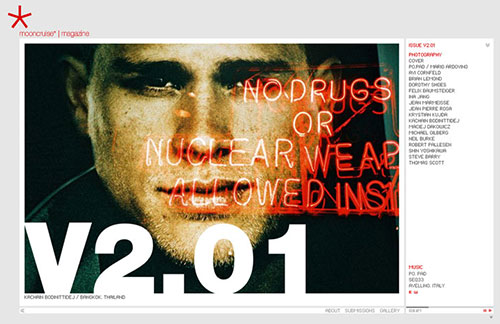Digital Photography Review write:
Leica has announced that all new M system lenses will carry a new 6-bit code (painted in black/white dots) which will allow the upcoming digital M camera to identify which len is being used (up to 64 in 6-bit coding) and also to store this information in image metadata. As well as applying this coding to new lenses Leica has announced an upgrade service which allows owners of existing M series lenses to have the coding written onto each lens at a cost of 95 EUROs. The press release also hints that the new M series digital will appear in the second half of 2006 (at Photokina no doubt).
Wow, only 95 EUR (US $120 as of today) for six dots of paint? That’s a mere 16 EUR/US $20 each! It must be because they "are fabricated with unequaled mechanical and optical precision" and "have an extraordinary aura that can evoke feelings and emotions" like the rest of their range. (Sorry, but how seriously can you really take a company that have a "Leica Mythology" section on their web site?)
Here’s the press release (PDF):
Leica Camera AG, Solms will be giving the lenses of the Leica rangefinder system a new code on the bayonet ring in future to enable the planned digital Leica M camera to recognize the lens type. The information on the lens that is being used helps the camera to optimize image quality. All lenses leaving the factory from July 1st, 2006 onwards will have the new coding, although they can still be fully used with the current analog cameras LEICA MP and LEICA M7 as well as classic models built after 1954. Lenses in the current range as well as many earlier models can be retrofitted at the cost of the owner to benefit from the image optimization in the camera. The lenses are compatible with the planned digital M camera even without retrofitting, except that the additional features cannot be used.
The lens coding is called ‘6-bit coding’ because six fields in the bayonet ring are marked in black or white to represent a number from 1 to 64 in binary code. The planned digital M camera reads this information optically and can identify the lens on the basis of this code. Apart from the improvement in image quality, this information is also written into the EXIF image file.
"On account of their legendary quality, nearly all Leica M lenses are ideal for digital use. However, the new 6-bit coding also uses the performance reserves in the image processing of the camera to give our customers the excellent image result they expect from Leica," says Rainer Bültert, product manager for the M system at Leica Camera AG.
Lenses bought in the past will be converted at the request of the customer for 95 euros at the Customer Service of Leica Camera AG in Solms or the Leica agencies of other countries.
Many of the lenses made from 1963 onwards can be converted. A list of such models is available on the following pages or from the Leica Info-Service (Tel. 06442/208-111). The only lens in the current range that will not be given a 6-bit coding is the LEICA APO-TELYT-M 135 mm f/3.4. It is not codable later, either, as its extension factor of 1.33 makes it unsuitable for use on the planned digital M camera. The launch of the digital Leica rangefinder camera is planned for the second half of 2006.
List of present lenses that can be updated
Name Color Order no. Delivered from Elmarit-M 21mm f/2.8 ASPH. Black 11135 1997 Summicron-M 28mm f/2 ASPH. Black 11604 2000 Summilux-M 35mm f/1.4 ASPH. Black 11874 1994 Summicron-M 35mm f/2 ASPH. Silver 11882 1996 Summilux-M 50mm f/1.4 ASPH. Black 11891 2004 Summicron-M 50mm f/2 Black 11826 1994 Elmar-M 50mm f/2.8 Black 11831 1995 Summilux-M 75mm f/1.4 Black 11810 1998 Apo-Summicron-M 90mm f/2 ASPH. Black 11884 1998 Macro-Elmar-M 90mm f/4 Black 11633 2002 Macro-Adapter M Black 14409 2002 Discontinued lenses that can be updated
Besides those presently available, even lenses that were discontinued quite a while ago can be updated (see list below). Since Leica Camera AG regards system compatibility as a vital virtue, many lenses introduced as long ago as 1963 can be updated.
Name Color Order No. Delivered from-until Elmarit-M 21mm f/2.8 Black 11134 1980-1997 Elmarit-M 21mm f/2.8 ASPH. Silver 11897 1997-2004 Elmarit-M 24mm f/2.8 ASPH. Silver 11898 1996-2005 Elmarit-M 28mm f/2.8 Black 11804 1979-1992 Elmarit-M 28mm f/2.8 Black 11809 1992-2005 Tri-Elmar-M 28-35-50mm f/4 ASPH. Black 11890 1998-2000 Tri-Elmar-M 28-35-50mm f/4 ASPH. Silver 11894 1999-2000 Summilux-M 35mm f/1.4 ASPH. Silver 11883 1994-2004 Summicron-M 35mm f/2 Black 11310 1979-1996 Summicron-M 35mm f/2 Silver 11311 1993-1996 Noctilux-M 50mm f/1.0 Black 11821 1975-1994 Summilux-M 50mm f/1.4 Black 11868 1992-2004 Summilux-M 50mm f/1.4 Silver 11856 1992-2004 Summicron-M 50mm f/2 Black 11817 1969-1979 Summicron-M 50mm f/2 Black 11819 1979-1994 Summicron-M 50mm f/2 Silver 11825 1992-1994 Summilux-M 75mm f/1.4 Black 11814 1980-1982 Summilux-M 75mm f/1.4 Black 11815 1982-1998 Summicron-M 90mm f/2 Black 11136 1980-1989 Summicron-M 90mm f/2 Silver 11137 1993-1989 Apo-Summicron-M 90mm f/2 ASPH. Silver 11885 2002-2004 Tele-Elmarit-M 90mm f/2.8 Black 11800 1973-1989 Elmarit-M 90mm f/2.8 Silver 11808 1997-2004 Elmarit-M 135mm f/2.8 Black 11829 1963-1997 Please ask either your authorized Leica dealer or Customer Service in Solms to perform the update. The latter will be happy to inform you on this subject. Customer Service is available under the phone number +49 (0)6442 208-189.
